Coconut Panna Cotta
Enjoy a taste of Italian indulgence with my Coconut Panna cotta.
Made with creamy coconut milk, rich cream, and a hint of sugar, this impressive dessert boasts a perfectly set, velvety texture making this an irresistible finale to any meal. This luxurious treat will transport you to Italy in every spoonful!
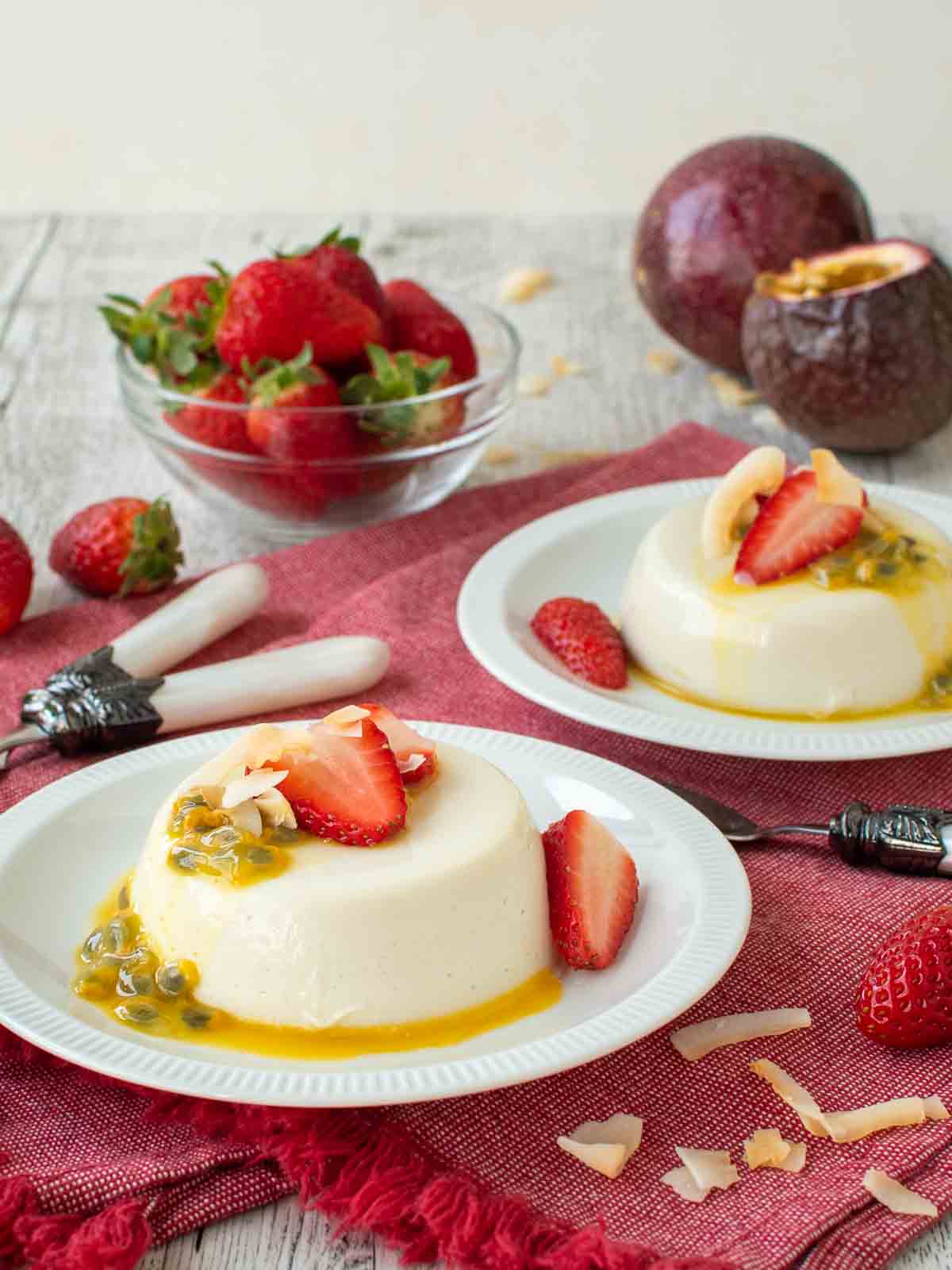
Italian desserts vary from super simple like my baked peaches or these simplified tiramisu cups to ones that are a little more complicated like Italian cream puffs or rum cake. But one of the most loved Italian desserts around the world is panna cotta and my coconut milk panna cotta is everything that’s perfect about this dessert!
Delicate, gelatin-set Panna cotta originated in Piedmont, the beautiful region where my husband’s family is from. My panna cotta using coconut milk is easy to make, appeals to all ages and can be made in advance. Follow my step by step instructions and tips for panna cotta perfection!
Why you love this recipe
- Flavor – this Coconut Panna Cotta is the ideal combination of rich cream and delicate coconut flavor. A little touch of vanilla enhances and complements while it has just the right amount of sugar to adds sweetness.
- Texture – if you’re looking for the perfect panna cotta that is barely set so that it just holds, then look no further. Plus you’ll love the creaminess and lusciousness of the heavy cream and coconut milk.
- Versatility – there are countless ways to serve this dessert. Have a look at the “Serving Suggestions” section below. Panna cotta toppings are only limited to your imagination.
- Egg and gluten free – while this is a pudding-like dessert, it’s completely egg and gluten free.
- Looks great – that’s right! This is the dessert you make when you want to impress! Dress it up to look amazing and no one will know how easy it actually is to make!
For complete ingredient quantities and full instructions, please scroll to the printable recipe card at the bottom of the page.
Ingredients
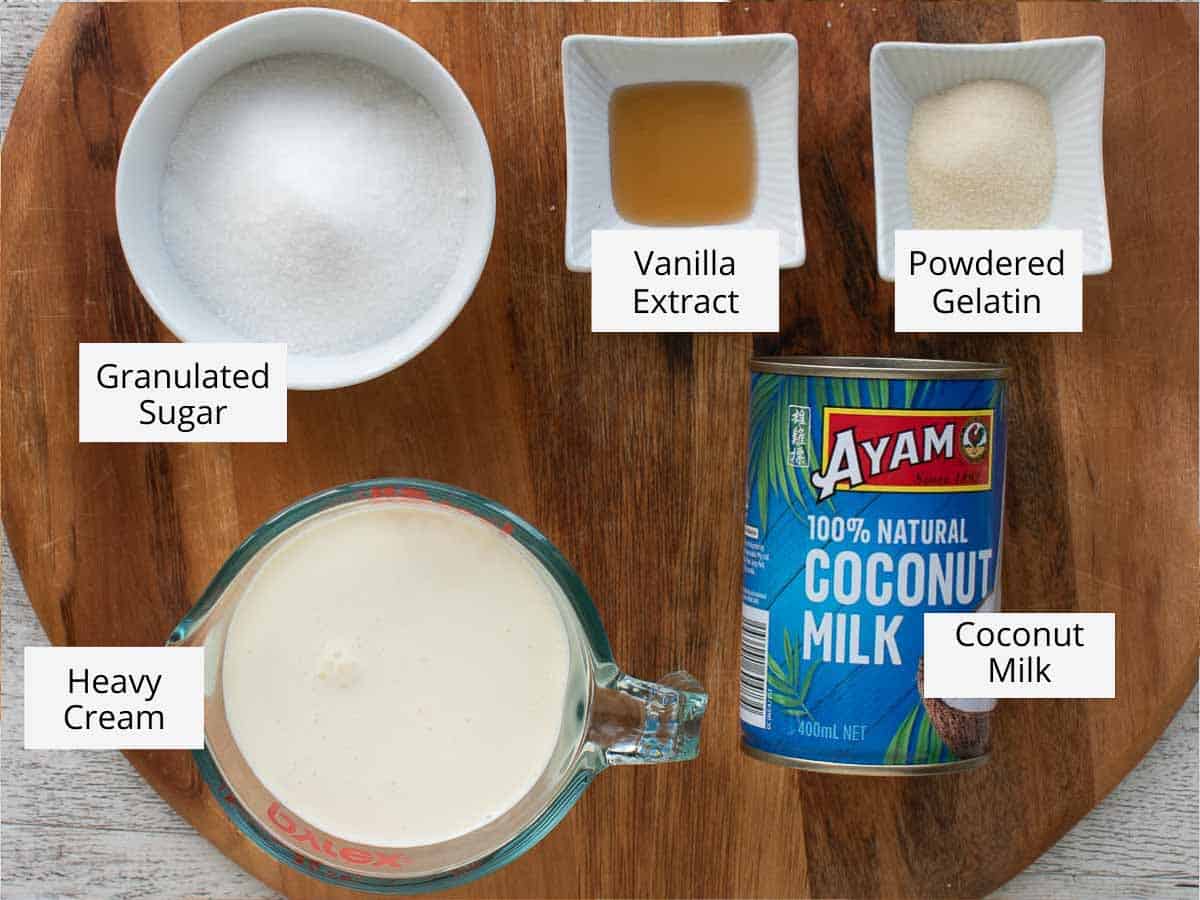
- Coconut milk – use canned full fat coconut milk for this panna cotta recipe. I have found success with a brand that has no additives just pure coconut milk with about 15% fat. Canned coconut milk varies from brand to brand. Buy the best you can find.
- Cream – heavy cream or pouring cream works best.
- Granulated sugar – regular white granulated sugar
- Powdered gelatin – I prefer unflavoured gelatin powder (or granules) for its ease of use. Gelatin is a flavorless and colorless product made from the collagen of animals, usually cows or pigs. It comes in powdered or sheet form and is readily available in supermarkets.
- Vanilla extract – use vanilla extract, not vanilla essence for the best flavor.
See recipe card for quantities.
Instructions
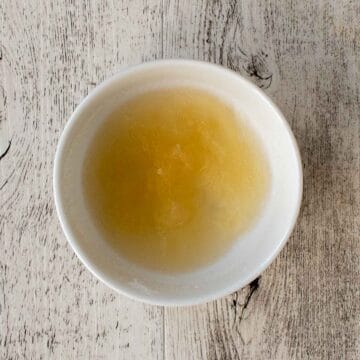
In a small bowl sprinkle the powdered gelatin over the water and allow to bloom.
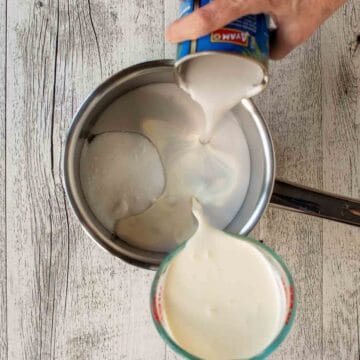
Combine coconut milk, cream and sugar in a medium saucepan and heat to until it almost simmers.
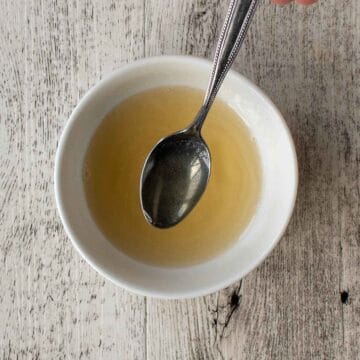
Heat the bloomed gelatin in the microwave to melt.
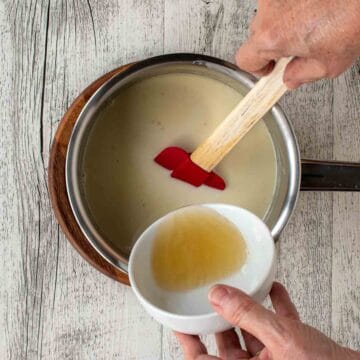
Add to the heated coconut milk mixture. Stir thoroughly.
Allow to cool then pour into molds or cups to set for at least 6 hours or overnight.
Hint: For a smooth dessert, avoid whisking as this creates bubbles Also strain the coconut milk mixture through a fine sieve before pouring it into dessert glasses, ramekins or molds.
Substitutions.
- Gelatin powder – if you’re experienced with gelatin leaves and prefer to use those, feel free.
- Vanilla Extract – substitute with a little coconut extract if you’d rather have an intense coconut flavour.
- Vegetarian – the gelatin powder can be substituted with agar agar for a vegetarian panna cotta.
Variations
- Citrus – add a long strip of citrus zest (orange, lemon or lime) to the coconut milk mixture when heating. Remove before adding gelatin
- Basil – heat a handful of fresh basil leaves with coconut milk, cream and sugar. Remove before adding gelatin.
- Spiced – drop a cinnamon stick, a couple of cardamom seeds or a piece of ginger into the coconut milk mixture as it heats. Remove before adding gelatin.
Have you made my Nutella Panna Cotta? It’s just as good as this version.
Equipment
Aside from the usual kitchen equipment like bowls, a saucepan, and spoons, you will need ramekins to set the panna cotta. Once the panna cotta is set in ramekins, you can turn them out onto a plate for serving. Alternatively, the panna cotta can simply be set in dessert glasses for serving.
Storage
Any leftover coconut panna cotta can be stored in the fridge covered in plastic for up to 3 or 4 days. It will keep longer than that; however, the gelatin desserts can harden and become rubbery.
Top tip
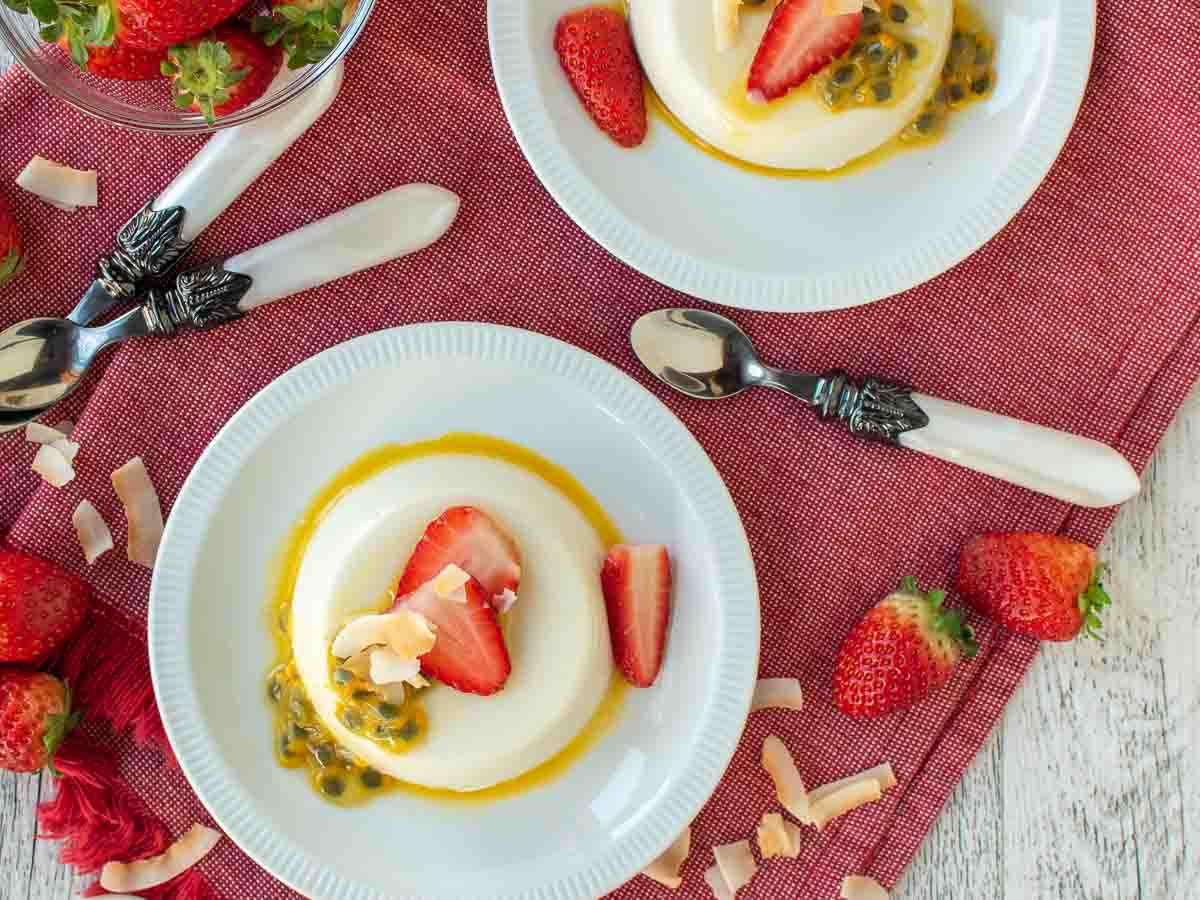
When making Italian panna cotta, it’s essential to bloom the gelatin before adding it to the heated cream and coconut milk mixture. This is simple to do, but remember to sprinkle gelatin powder over cool water, not the other way around, or you may end up with clumps of gelatin.
Once the gelatin has bloomed, which just means that it has swelled and absorbed the water, heat it in the microwave until clear with no lumps. Alternatively, stand the bowl of bloomed gelatin in a heatproof bowl of hot water and stir until melted.
Never boil the cream and coconut milk. Even though panna cotta means “cooked cream” in Italian, the cream should never boil. Slowly heat the coconut milk and cream until just before simmering. Stir regularly so that it doesn’t scorch on the bottom.
Once the gelatin has been added and dissolved, let the coconut milk mixture cool completely before pouring it into glasses, molds, or ramekins to set. To ensure that the panna cotta is completely silky smooth, pour it through a fine sieve.
How to remove panna cotta from mold
If you want to unmold the panna cotta, very lightly oil the molds or ramekins with flavorless oil or coconut oil before pouring in the cooled panna cotta mixture and allow to set for at least 6 hours. I usually make these the night before.
To unmold, you can dip the molds in hot water for 5-10 seconds. The very gently press around the edge of the panna cotta with clean fingertips or a spoon to break the vacuum. I like to gently shake it slightly to loosen it. Invert the mold onto a serving plate. Hold the plate and the mold with your fingers while shaking gently. You’ll hear the panna cotta release.
FAQ
If your panna cotta is hard and doesn’t have the wobble you’re looking for, it means that you’ve used too much gelatin or too little liquid for the amount of gelatin in the recipe. Maybe you didn’t level off the measuring spoon when measuring the gelatin powder, or you cut back on the liquid. Your panna cotta won’t be inedible; just not perfect. Next time, take care when measuring or alternatively reduce the amount of gelatin powder.
Yes, you can make panna cotta with coconut cream. It will have a richer and creamier mouthfeel and may set more firmly due to the extra fat contained in coconut cream.
This recipe for coconut panna cotta isn’t vegan because it uses gelatin powder as the setting agent. You can substitute agar agar for the gelatin powder if you want a vegan coconut panna cotta.
Serving Suggestions
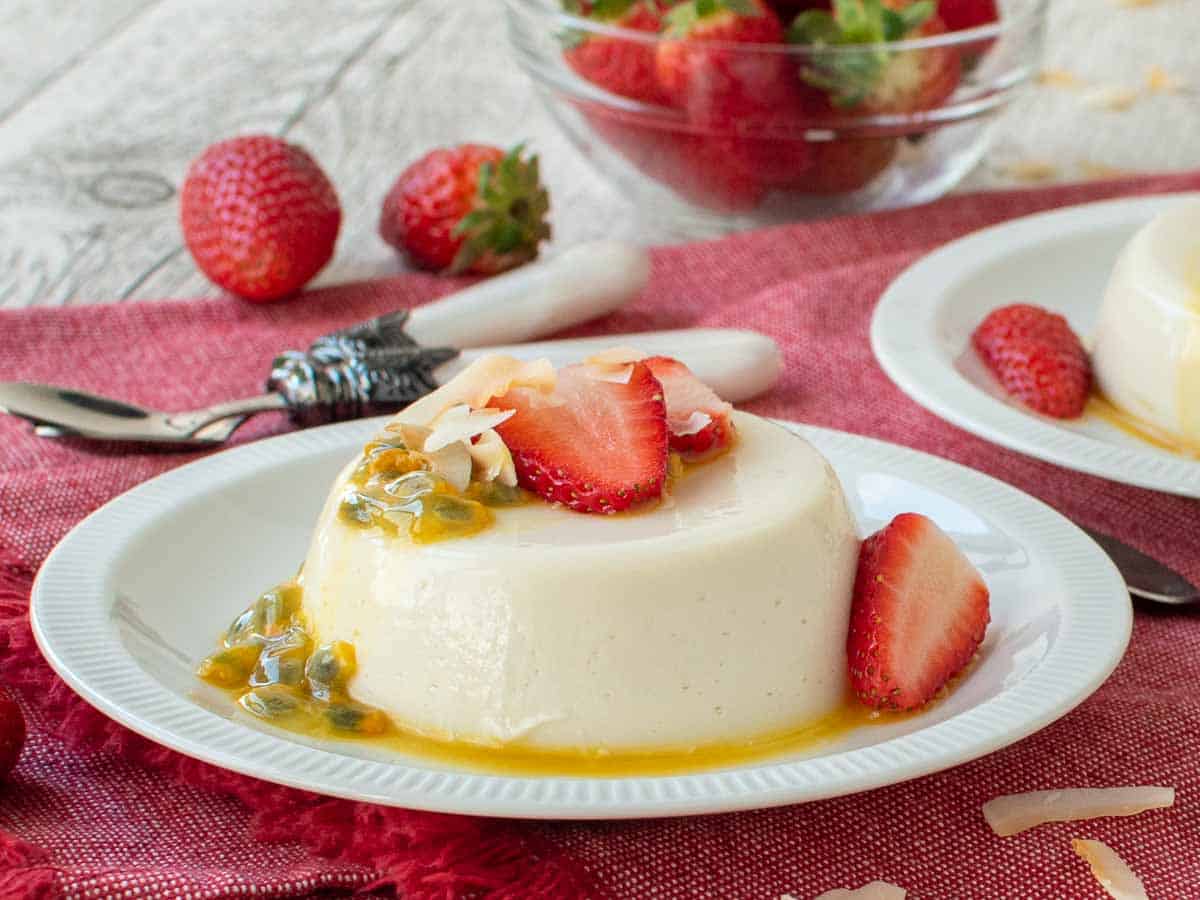
You can serve this creamy Coconut Panna Cotta in so many ways! Fresh fruit like strawberries, passion fruit, and a sprinkle of toasted coconut flakes make such an easy topping. A topping of shaved white or dark chocolate is simple and elegant.
But if you’re in the mood for something more, why not try raspberry compote or blueberry compote? Cherry sauce and lemon curd are also wonderful with this Italian dessert. Regardless of the way you serve this Coconut Panna Cotta, you’re sure to receive compliments and rave reviews!
Made this recipe?
Please let me know if you liked it by leaving a ★★★★★ star rating and a review below. And remember to subscribe to my newsletter – it’s free!
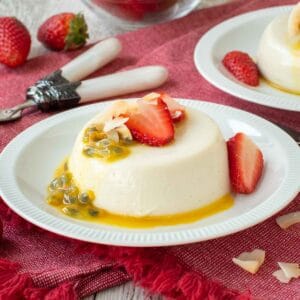
Coconut Panna Cotta Recipe
Ingredients
- 2 teaspoons powdered gelatin See Note 1 and 2
- 2 tablespoons water
- 1 can (13½ ounce) coconut milk (400 mls) See Note 3
- 1 ½ cups heavy cream (355 mls) See Note 4
- ½ cup granulated sugar (100 grams) See Note 5
- 1 teaspoon vanilla extract
- Pinch of salt
To serve
- Strawberries, passion fruit pulp and toasted unsweetened coconut flakes
Instructions
- Place 2 tablespoons of water in a small bowl and sprinkle powdered gelatin over the surface and stir well. Let stand for 5-10 minutes to soften and bloom.
- Combine the canned coconut milk, cream, granulated sugar, vanilla extract and salt into a medium saucepan.
- Heat until just before boiling point stirring regularly. A few bubbles will start forming around the edges of the saucepan, steam will rise and the sugar should be dissolved.
- Remove from heat.
- Melt the bloomed gelatin in the microwave for 10-20 seconds until it is clear and there are no lumps.
- Stir the melted gelatin mixture into the cream/coconut milk mixture and immediately mix until smooth and dissolved. If the gelatin hasn’t fully dissolved, return the saucepan to the stove and heat gently over low heat. Stir constantly and don’t let the mixture boil.
- Pour into a 4 cup jug and place in the fridge until cooled completely but not setting. Stir every now and then to prevent a skin forming on top.
- Use a little flavorless oil or coconut oil to grease ¾ cup molds or ramekins. Then strain the cooled coconut panna cotta mixture and divide between the molds or ramekins.
- Cover with plastic wrap and refrigerate for at least 6 hours, or until completely set.
To unmold and serve
- Dip the molds in hot water for 5-10 seconds. If the molds are metal only dip for 5 seconds.
- Gently press around the edge of the panna cotta with clean fingertips or a spoon to break the vacuum.
- Shake the mold slightly to loosen the panna cotta then invert the mold onto a serving plate.
- Hold the plate and the mold with your fingers while shaking gently. You’ll hear the panna cotta release.
- Top the coconut panna cotta with sliced strawberries, passion fruit pulp and toasted coconut flakes.
- Serve immediately.
Notes
- This amount of powdered gelatin results in a soft wobbly set. If you prefer a firm set use ½ to 1 teaspoon of powdered gelatin extra.
- The gelatin powder I have used is platinum strength. As a guide, 2 teaspoons will set 2 cups plus 4 teaspoons of liquid (or 2 metric cups (500mls).
- Choose a good quality, pure coconut milk that has a distinct coconut taste and at least 15% fat.
- You can use coconut milk in place of the heavy cream for a more intense coconut flavor however coconut milk can have a greyish color and therefore the panna cotta may look grey (not white).
- Taste the mixture before cooling. You may prefer a sweeter taste. In that case, add a little more sugar to your liking.
- Bloom the powdered gelatin in cool water.
- Never boil the cream and coconut milk just heat slowly until just before simmering.
- Melt bloomed gelatin (but don’t boil) thoroughly before adding to coconut milk mixture then mix thoroughly. Don’t whisk.
- Allow the coconut milk mixture cool completely and pass through a fine sieve before setting in molds.
Nutritional Estimate Per Serving
Nutritional Disclaimer
Nutritional information is an estimate provided by an online nutrition calculator. For accurate results, it is recommended that the nutritional information be calculated based on the ingredients and brands you use.

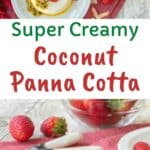

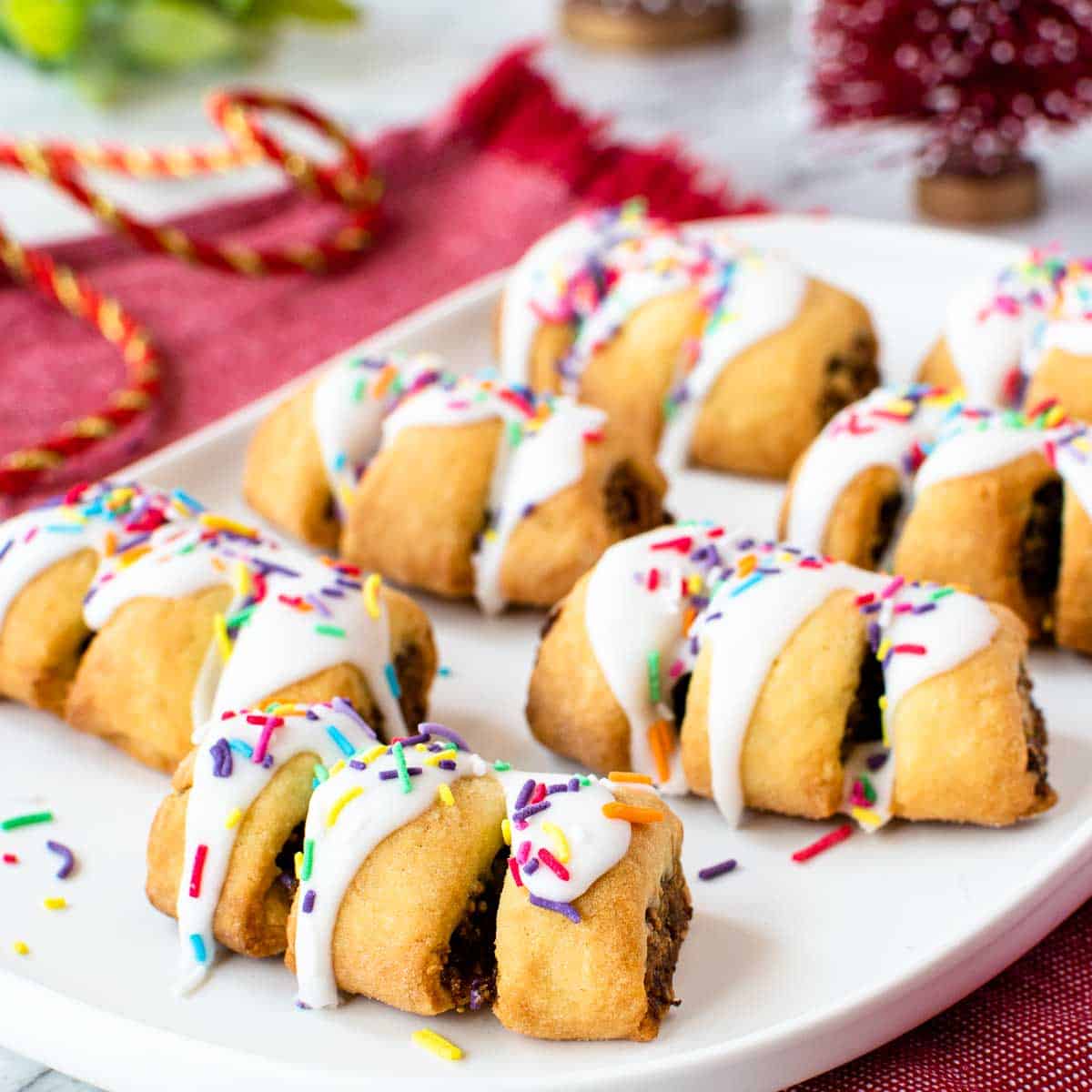
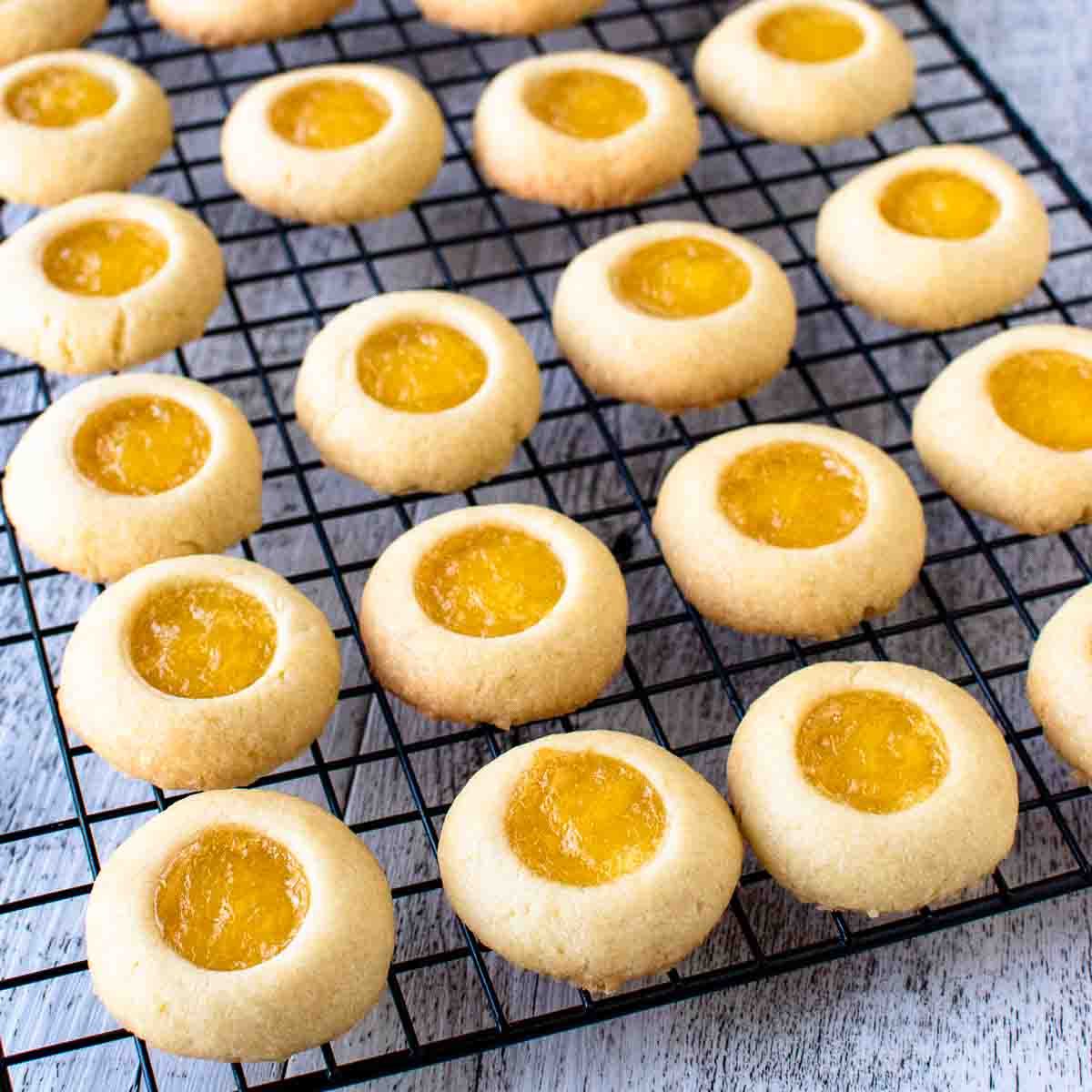
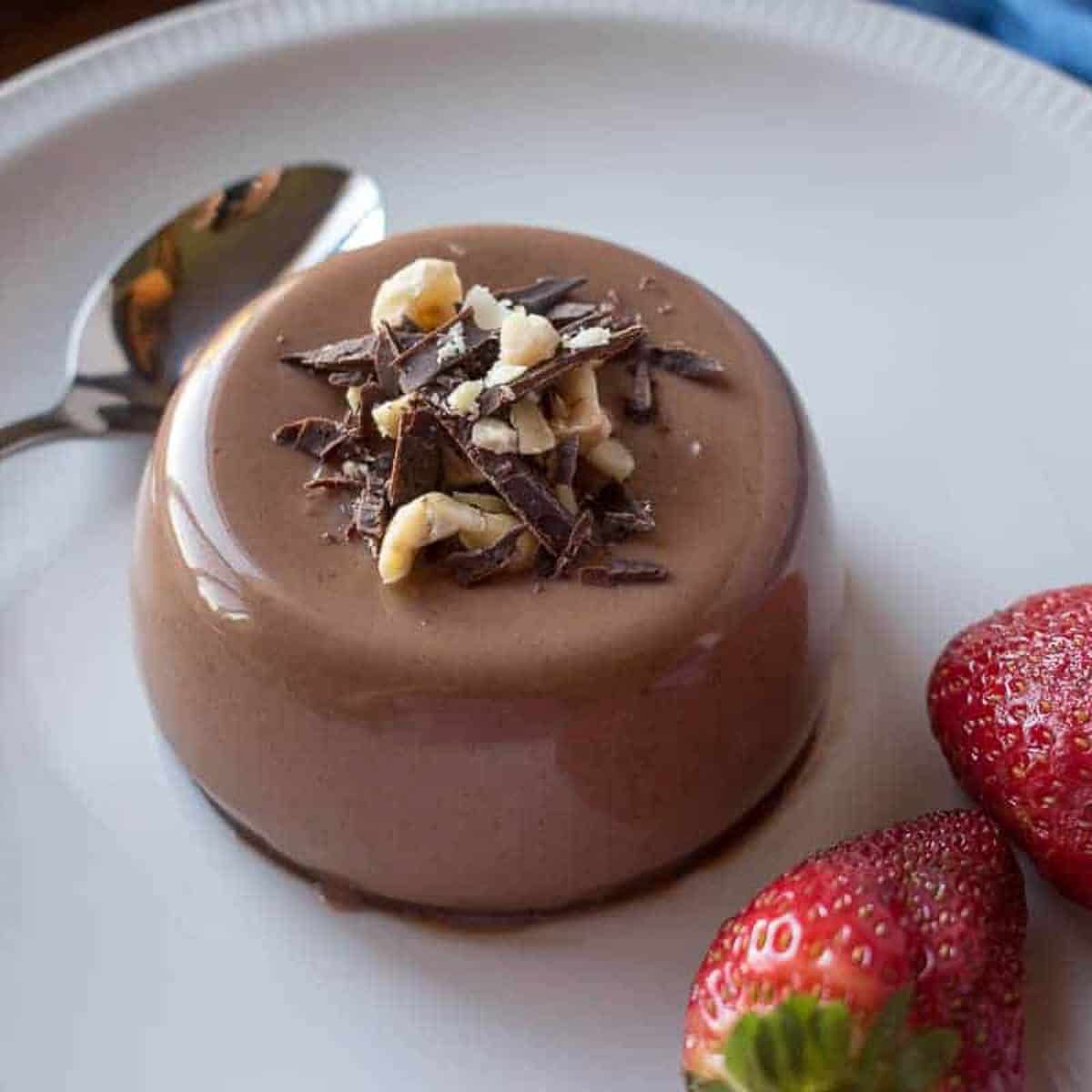
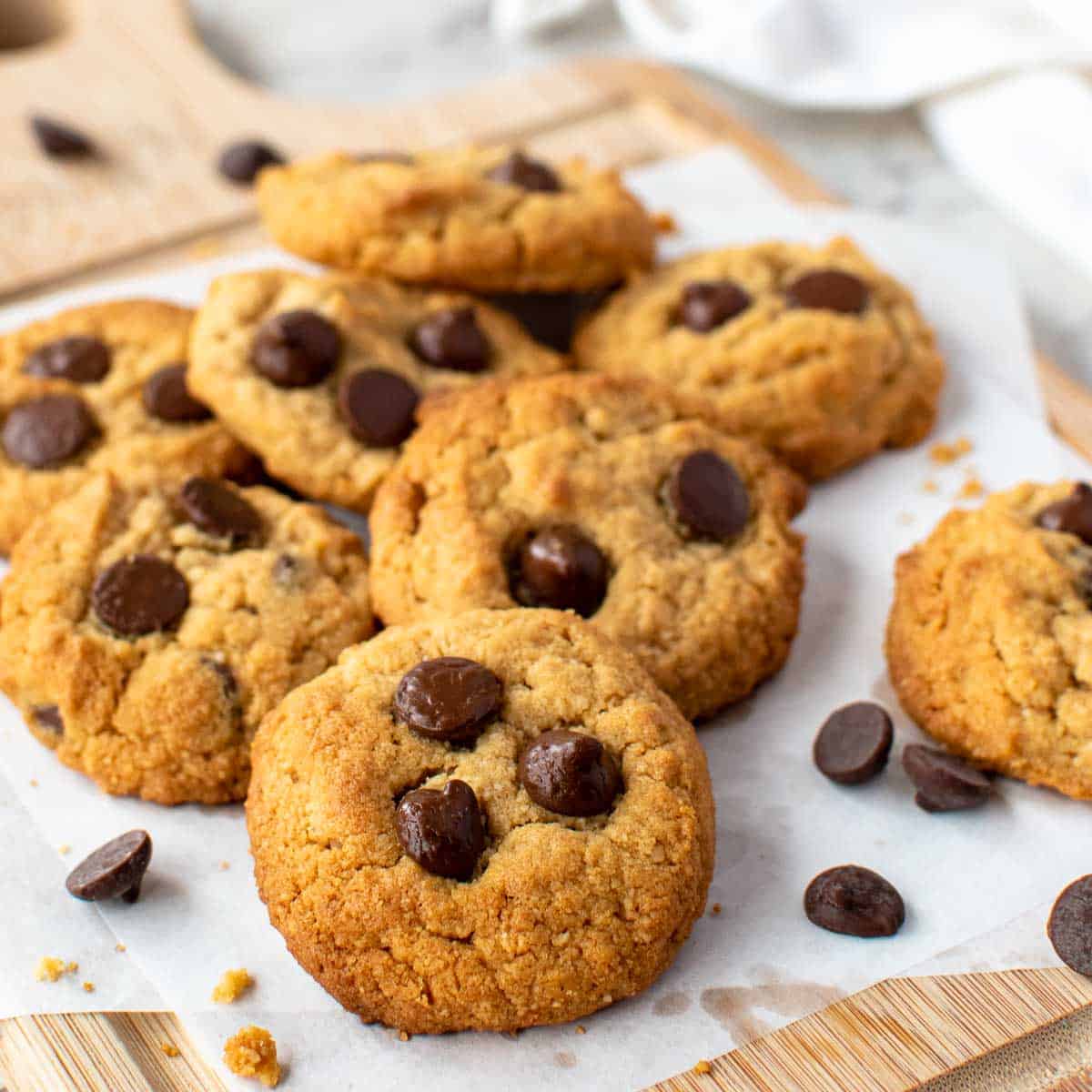
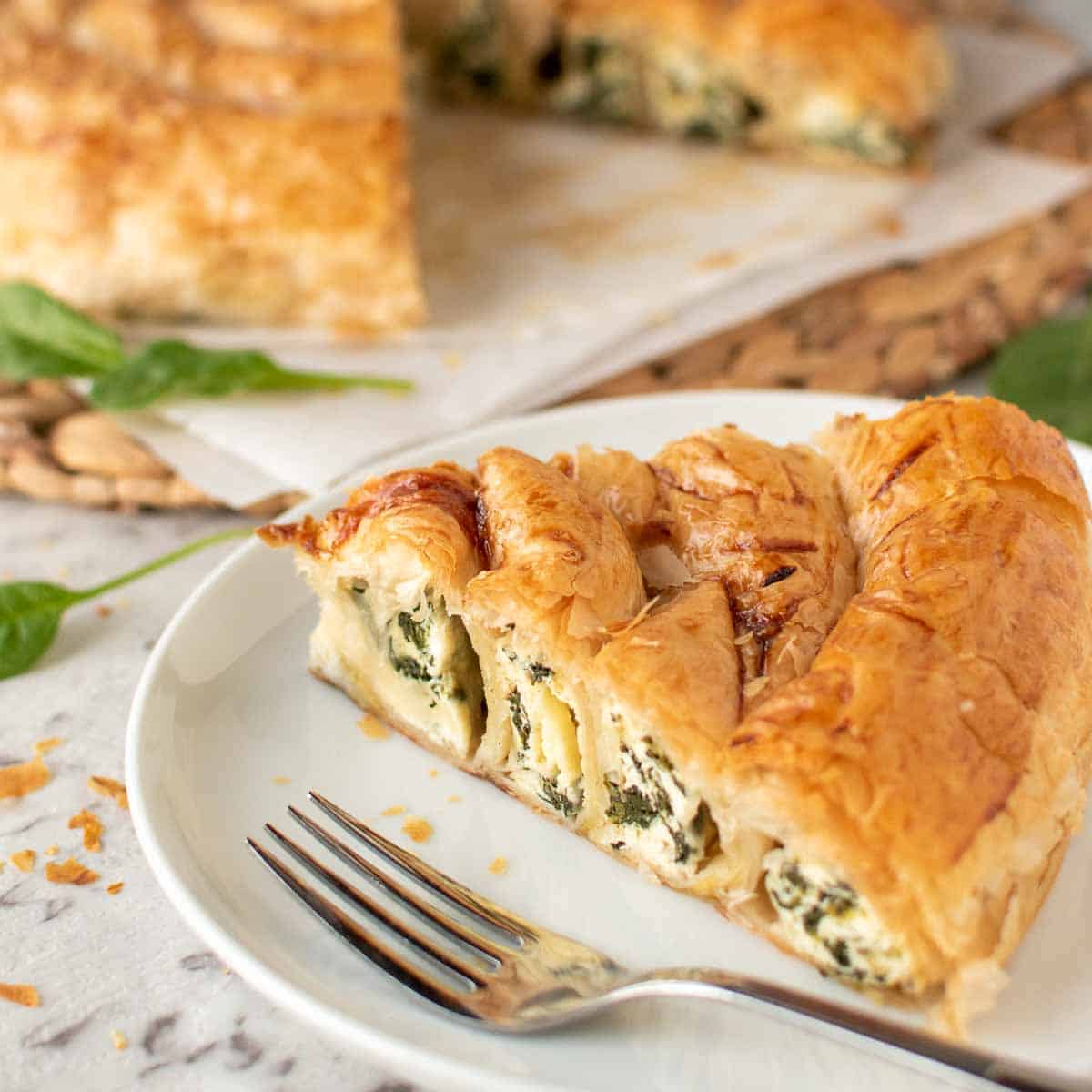
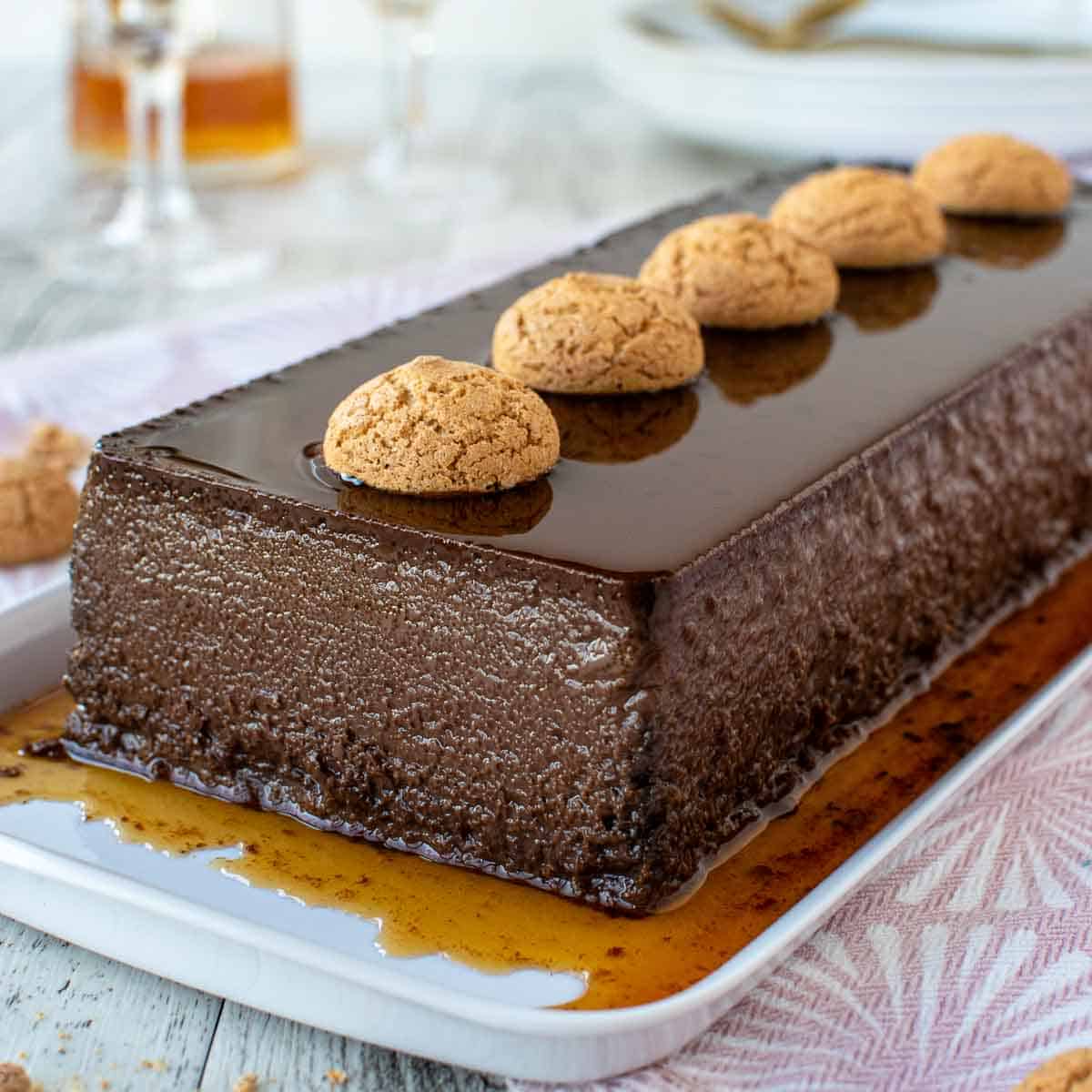
Absolutely delicious, lovely coconut flavour with a perfect wobble . Not berry season so served with poached tamarillos and a coconut and oat crumble.
Thank you for the wonderful feedback, Viv! This is my daughter-in-law’s favorite dessert. The poached tamarillos and crumble sound delicious!
Followed recipe exactly. Great texture but soooooo bland, no taste of coconut at all.
Did you read the note under “substitutions”? It says, if you would like a more intense coconut flavor, substitute coconut extract or essence for the vanilla extract. This coconut panna cotta has a mild but definite taste of coconut. The quality of coconut milk makes all the difference. Be sure to choose a pure coconut milk with no additives. Taste the liquid before setting as you may prefer a sweeter panna cotta.